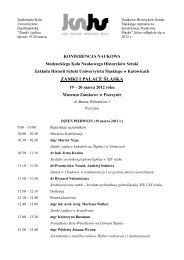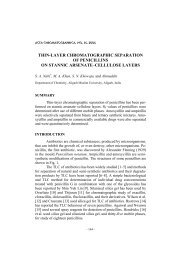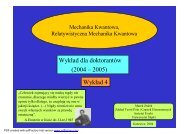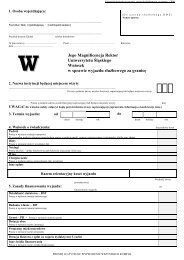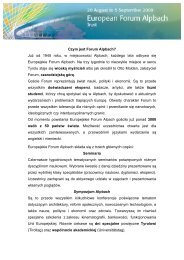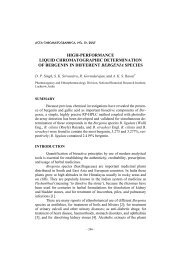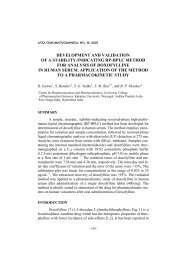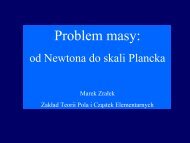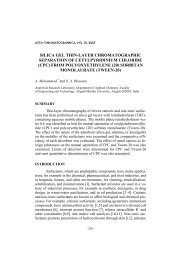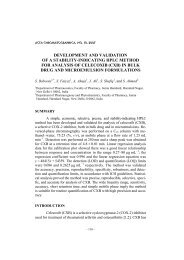Analysis of sugars by micellar liquid chromatography with UV ...
Analysis of sugars by micellar liquid chromatography with UV ...
Analysis of sugars by micellar liquid chromatography with UV ...
You also want an ePaper? Increase the reach of your titles
YUMPU automatically turns print PDFs into web optimized ePapers that Google loves.
ACTA CHROMATOGRAPHICA, NO. 16, 2006ANALYSIS OF SUGARS BY MICELLAR LIQUIDCHROMATOGRAPHY WITH <strong>UV</strong> DETECTIONF. Momenbeik and J. H. Khorasani *Department <strong>of</strong> Chemistry, University <strong>of</strong> Isfahan, Isfahan, 81746-73441, IranSUMMARYA <strong>micellar</strong> <strong>liquid</strong> chromatographic procedure is described for simultaneousdetermination <strong>of</strong> <strong>sugars</strong> previously derivatized <strong>with</strong> 4-aminobenzoicacid ethyl ester (4-ABEE). The optimized conditions, determined<strong>by</strong> use <strong>of</strong> the super-modified simplex method, were temperature 30°C, mobilephase containing 17.3 mM sodium dodecyl sulfate, 0.01 M phosphatebuffer, pH 6.69, and 7.73% (v/v) ethanol, and <strong>UV</strong> detection at 307 nm. The4-ABEE derivatives were separated in 10 min but a peak assigned to excessreagent appears at 13 min. Analytical data including linearity (r > 0.9987),limit <strong>of</strong> detection (35.47–81.74 µg mL −1 ), precision (RSD < 5.73%), andaccuracy, measured <strong>by</strong> determination <strong>of</strong> recovery (>91%), support the usefulness<strong>of</strong> the proposed method for measuring <strong>sugars</strong>. When the proposedmethod was applied to the analysis <strong>of</strong> <strong>sugars</strong> in an infant formula and asample <strong>of</strong> sorghum syrup the results were in good agreement <strong>with</strong> the contentreported <strong>by</strong> manufacturer and <strong>with</strong> results obtained <strong>by</strong> refractive indexdetection.INTRODUCTIONCarbohydrates are among the most abundant compounds in the plantworld, and the analysis <strong>of</strong> <strong>sugars</strong> and sugar mixtures is <strong>of</strong> considerableimportance to the food and beverage industries [1]. A variety <strong>of</strong> chromatographicsystems including paper and thin-layer <strong>chromatography</strong>, gas–<strong>liquid</strong><strong>chromatography</strong> <strong>with</strong> flame ionization or mass spectrometric detection, andhigh-performance <strong>liquid</strong> <strong>chromatography</strong> (HPLC) can be used to separateand analyze monosaccharides [1].In HPLC, detection <strong>of</strong> unmodified carbohydrates can only be performedspectroscopically at 195 nm or <strong>by</strong> amperometric or refractive indexdetection, all <strong>of</strong> which are associated <strong>with</strong> low sensitivity [2]. Derivatization<strong>of</strong> carbohydrates serves multiple purposes [3]. Derivatization <strong>with</strong>- 58 -
<strong>UV</strong>-absorbing or fluorescent molecules significantly enhances detectionsensitivity <strong>of</strong> HPLC, capillary electrophoresis (CE), and polyacrylamidegel electrophoresis (PAGE). Most carbohydrates are hydrophilic and neutral.Derivatization <strong>with</strong> appropriate reagents changes these properties andcan assist their resolution, e.g. it can endow them <strong>with</strong> charge to facilitatetheir electrophoretic separation or <strong>with</strong> hydrophobicity to enable their efficientresolution <strong>by</strong> reversed-phase HPLC or <strong>micellar</strong> electrokinetic <strong>chromatography</strong>(MEKC).As recently reviewed <strong>by</strong> Lamari et al. [2] one <strong>of</strong> the most popularreactions used for derivatization <strong>of</strong> carbohydrates is reductive amination;a large variety <strong>of</strong> reagents, including <strong>UV</strong> active and fluorophore derivatizationreagents such as 4-aminobenzoic ethyl ester (4-ABEE) [4–8], havebeen suggested for this purpose. Derivatization <strong>of</strong> reducing <strong>sugars</strong> <strong>with</strong> 4-ABEE is easy and requires no special equipment. The method is also highlysensitive and eliminates the doublet that can arise as a result <strong>of</strong> mutarotation<strong>of</strong> the free reducing end <strong>of</strong> the <strong>sugars</strong>. 4-ABEE-derivatized monosaccharideshave been separated on an amino-bonded vinyl alcohol copolymergel column [7], on C 18 columns [4,6], and on narrow-bore C 8 columns[8].Micellar <strong>liquid</strong> <strong>chromatography</strong> (MLC) has several advantages overother chromatographic methods, including low cost, low toxicity, low volatility,the possibility <strong>of</strong> simultaneous separation <strong>of</strong> ionic and non-ioniccompounds, direct injection <strong>of</strong> biological fluids, and high separation selectivity,because <strong>of</strong> the involvement <strong>of</strong> many adjustable conditions [9].The primary objective in the development <strong>of</strong> MLC separations isto optimize chromatographic performance <strong>by</strong> adjustment <strong>of</strong> such experimentalconditions as temperature, type and concentration <strong>of</strong> organic modifier,pH, and concentration <strong>of</strong> surfactant [9]. HPLC separations are mainlymodified <strong>by</strong> varying the composition <strong>of</strong> the mobile phase. Optimization is<strong>of</strong>ten effected <strong>by</strong> varying conditions one at a time, while keeping the othersfixed, until an optimum is reached for each variable. But this is far fromadequate and requires many experiments to be performed. This can bevery time-consuming and, probably more important for complex chemicalsystems, interactions between the variables might mean that the optimumobtained will depend on the initial conditions chosen. Several different experimentaldesigns have been developed to reduce the number <strong>of</strong> experimentsand the amounts <strong>of</strong> chemicals used. The iterative regression optimizationstrategy is the most popular method for simultaneous optimization<strong>of</strong> different conditions in MLC separations [10–12]. The simplex method,- 59 -
one <strong>of</strong> the most efficient optimization designs, was first introduced in HPLCseparations <strong>by</strong> Morgan and Deming [13,14]. The modified simplex procedurewas developed to overcome the disadvantages <strong>of</strong> the original simplexmethod [15] and has been used in MLC <strong>by</strong> Srijaranai and co-workers [16].The super-modified simplex (SMS), which was introduced <strong>by</strong> Routh andco-workers [17], is a modification <strong>of</strong> the modified simplex method.In this paper we report, for the first time, the separation and determination<strong>of</strong> <strong>sugars</strong> including glucose, xylose, arabinose, maltose, and lactose<strong>by</strong> MLC. The conditions, including sodium dodecyl sulfate (SDS) concentration,pH, and amount <strong>of</strong> ethanol in the mobile phase, were optimized<strong>by</strong> use <strong>of</strong> the SMS method. The optimized method was applied to the analysis<strong>of</strong> <strong>sugars</strong> in an infant formula and in a sample <strong>of</strong> sorghum syrup.EXPERIMENTALReagentsAnalytical-grade glucose, maltose, lactose, xylose, arabinose, 4-aminobenzoicacid ethyl ester, sodium cyanoborohydride, HPLC-grade methanol,acetonitrile, SDS, sodium dihydrogen phosphate, sodium monohydrogenphosphate, and reagent grade ethanol, 1-propanol, 2-propanol, and 1-butanol all were purchased from Merck (Darmstadt, Germany). Doublydistilled, deionized water was used in all experiments.A 500 mM stock solution <strong>of</strong> SDS was prepared in filtered waterand diluted <strong>with</strong> water. Organic solvents and phosphate buffer were addedto the mobile phase where necessary. All mobile phases and solutions werefiltered through 0.45 µm pore size Nylon membranes (Millipore, Bedford,MA, USA).ApparatusChromatography was performed <strong>with</strong> a Crystal 200 series HPLCpump (ATI Unicam, Cambridge, UK) equipped <strong>with</strong> a Rheodyne (Cotati,CA, USA) model 7125 manual injector <strong>with</strong> 20-µL loop, a PU4225 <strong>UV</strong>detector (Philips, Cambridge, UK), a RefractoMonitor IV refractive-indexdetector (LDC Analytical, FL, USA), a Kromasil 100-10NH 2 column (10µm, 250 mm × 4.6 mm i.d.) from Hichrom (Berkshire, UK), a SpherisorbODS analytical column (5 µm, 100 mm × 3.9 mm) from Unicam (Cambridge,UK), and RP-18 and amino guard columns (7 µm, 15 mm × 3.2 mm)from Applied Biosystems (San Jose, CL, USA). The analytical column was- 60 -
water-jacketed and thermostatted <strong>with</strong> an NB-33722 Ultra-Thermostat(Colora, Lorch, Germany). The mobile phase flow rate was 1 mL min −1 .The dead volume was determined <strong>by</strong> injecting water. Chromatographiccalculations were performed <strong>by</strong> means <strong>of</strong> a Unicam 4880 data-handlingsystem.Derivatization ProcedureThe <strong>sugars</strong> were derivatized <strong>with</strong> 4-ABEE, at their reducing end,<strong>by</strong> the method <strong>of</strong> Wang et al. [18]. Each sugar, infant formula (Karicare, Nutricia,New Zealand), and sorghum syrup were separately weighed (500.0mg) and dissolved in 5 mL water. These solutions were always freshly prepared.The solutions were diluted to the desired concentrations immediatelybefore analysis. Each solution (50 µL) was mixed <strong>with</strong> 200 µL reagentmixture (prepared <strong>by</strong> mixing 1 mmol 4-ABEE, 35 mg sodium cyanoborohydride,41 µL glacial acetic acid, and 350 µL methanol) and the mixturewas heated at 80°C for 30 min. After cooling to ambient temperature 5 mLdistilled water was added. The aqueous phase was extracted <strong>with</strong> 5 mLchlor<strong>of</strong>orm to remove excess 4-ABEE and the aqueous layer was subjecttedto HPLC analysis.RESULTS AND DISCUSSIONOptimization <strong>of</strong> Temperature and Type <strong>of</strong> Organic ModifierAlthough it is not usually possible to set valid rules for the effect<strong>of</strong> temperature on HPLC separations, the column temperature affects pressure,analysis time, and separation [19]. The lower efficiency <strong>of</strong> MLC compared<strong>with</strong> conventional reversed phase <strong>liquid</strong> <strong>chromatography</strong> (RP-LC) isbecause <strong>of</strong> the higher viscosity <strong>of</strong> the <strong>micellar</strong> mobile phase. Column efficiencycould be improved at higher temperatures, because <strong>of</strong> faster masstransfer <strong>of</strong> solute between mobile and stationary phases. For several reasons,however, for example decomposition <strong>of</strong> sample or mobile phase, bubbleformation, effect on temperature-dependent chromatographic equilibria,and increasing solubility <strong>of</strong> silica, efficiency may decrease <strong>with</strong> increasingtemperature [19]. The basic criteria for determination <strong>of</strong> optimum temperaturewere the number <strong>of</strong> theoretical plates, N, and the asymmetry factor,B/A [20]; the effect <strong>of</strong> temperature on these was investigated using glucose(Glu) and maltose (Mal) derivatives as samples and 50 mM SDS as mobile- 61 -
phase. From data listed in Table I it was apparent that the most appropriatetemperature for separation <strong>of</strong> these compounds was 30°C.Table IEffect <strong>of</strong> temperature on the <strong>chromatography</strong> <strong>of</strong> the 4-ABEE derivatives <strong>of</strong> glucose andmaltoseTemperature k B/A N(°C) Glu Mal Glu Mal Glu Mal25 6.15 5.10 2.31 1.80 185 19730 5.70 4.80 2.38 1.80 194 27435 5.40 4.45 2.50 2.14 176 18240 5.30 4.45 3.05 2.52 160 166Addition <strong>of</strong> short-chained alcohols to the <strong>micellar</strong> mobile phase reducesthe thickness <strong>of</strong> the film <strong>of</strong> surfactant molecules covering the stationaryphase and, thus, enhances the efficiency [21]. The presence <strong>of</strong> thealcohol in the <strong>micellar</strong> mobile phase also alters the mechanism <strong>of</strong> retention<strong>by</strong> shifting the equilibria <strong>of</strong> the solutes from the stationary phase and themicelle toward the bulk aqueous phase, which leads to reduction <strong>of</strong> capacityfactors [22,23]. N and B/A were again used to select the best organicmodifier (Table II). The mobile phase was 50 mM SDS containing 5% (v/v)organic modifier and the column temperature was 30°C. The results showedthat substantial improvement <strong>of</strong> chromatographic efficiency could be achie-Table IIEffect <strong>of</strong> organic modifiers on chromatographic data for the 4-ABEE derivatives <strong>of</strong> glucoseand maltoseOrganic k B/A Nmodifier Glu Mal Glu Mal Glu MalNone 5.70 4.80 2.38 1.80 194 274Methanol 4.60 3.97 2.13 1.67 265 476Ethanol 4.22 3.40 2.02 1.76 473 522Acetonitrile 3.54 2.97 2.05 1.88 424 3691-Propanol 3.15 2.59 2.54 2.03 397 5352-Propanol 3.45 2.88 2.97 2.62 204 207Butanol 2.23 1.83 3.60 3.09 240 197- 62 -
ved <strong>by</strong> addition <strong>of</strong> organic solvent. Ethanol and 1-propanol were the mostsuitable for efficient separation <strong>of</strong> these compounds; because <strong>of</strong> the highhydrophilicity <strong>of</strong> <strong>sugars</strong> better selectivity was observed when ethanol wasused.Simultaneous Optimization <strong>of</strong> Ethanol Content, pH, and SDSConcentrationThe SMS program, which was written in GW-Basic, was used foroptimization <strong>of</strong> the conditions regarded as most important for separation<strong>of</strong> the mixture <strong>of</strong> sugar derivatives – amount <strong>of</strong> modifier (ethanol), SDSconcentration, and mobile phase pH. The chromatographic response function(CRF) given <strong>by</strong> eq. (1), was chosen as the criterion for the optimizationprocess [24].n 1CRF = ∑ −=i 1R + nia− bTA− TL+ c( T1− T0) (1)where R i is the resolution <strong>of</strong> adjacent peak pairs, n is the number <strong>of</strong> peaksdetected, T A is a specified analysis time (30 min in this work), T L and T 1Table IIIProgress <strong>of</strong> the SMS toward optimum conditions for analysis <strong>of</strong> the <strong>sugars</strong>Experiment SDS concentration Ethanol contentnumber (mM)(%, v/v)pH CRF1 20 7 6 12.592 40 3 3 7.013 30 5 4 8.524 50 2 5 4.575 100 8 3.67 4.396 36 4.1 4.53 8.147 17.3 7.73 6.69 13.658 17.7 7.66 6.63 13.449 26.6 5.82 5.24 12.8410 20 7 6 12.5911 18.5 7.29 5.85 13.5612 21.4 6.77 5.63 13.3913 22.8 6.5 5.46 13.0714 24.1 5.86 4.77 12.99- 63 -
are the retention times <strong>of</strong> the last and first peaks, respectively, T 0 is a specifiedminimum retention time (8 min in this work), and a, b and c are operator-selectableweightings (3/2, 0.2 and 1, respectively).The super-modified simplex program was started <strong>by</strong> introducinglower and upper boundaries for the three conditions ethanol concentration(1–10%), micelle concentration (10–100 mM), and pH (3–7). The initialsimplex consisted <strong>of</strong> the first four vertices (one more than the number <strong>of</strong>variables). Experiments 1–4 in Table III show the values <strong>of</strong> the three initialsimplex conditions. The experimental conditions and calculated CRF valuesare also presented in the table. Experiment 7 indicates the optimum conditions<strong>with</strong> the highest CRF value. All calculations were performed usingworksheets. The simplex was halted at experiment 14, because there wasno significant further improvement toward maximization <strong>of</strong> the CRF value,as shown in Fig. 1.Fig. 1CRF16141210864201 2 3 4 5 6 7 8 9 101112 13 14Vertex NumberCRF values corresponding to the experiment numbers during SMS optimisationFigure 2 shows the chromatogram obtained under the optimum conditions(vertex 7). It can be seen that the disaccharides and monosaccharideshave been separated in a reasonable time and <strong>with</strong> good resolution.- 64 -
Fig. 2Chromatogram obtained from 4-ABEE derivatives <strong>of</strong> the <strong>sugars</strong>. Column, Spherisorb ODS(5 µm, 100 mm × 3.9 mm); mobile phase, 17.3 mM SDS, 7.73% (v/v) ethanol, 0.01 Mphosphate buffer pH 6.69 at 30°C; flow rate, 1 mL min −1 , injection volume, 20 µL; detectionat 307 nm, AUFS = 0.5. Peaks: 1, lactose (0.50 mg); 2, maltose (0.50 mg); 3, glucose(0.25 mg); 4, arabinose (0.25 mg); 5, xylose (0.25 mg); 6, excess 4-ABEEValidationThe linearity <strong>of</strong> the dependence <strong>of</strong> response on concentration wasverified <strong>by</strong> triplicate analysis <strong>of</strong> nine standard solutions containing 0.125–20 mg mL −1 <strong>of</strong> each sugar, <strong>with</strong> xylose as internal standard (Table IV).The calibration plots for all the <strong>sugars</strong> revealed good correlation betweenthe peak area and sugar concentration; the regression coefficients were al-Table IVResults from linear least-squares analysis <strong>of</strong> calibration data obtained from analysis <strong>of</strong>the <strong>sugars</strong>PropertySample Linear rangeLOD(mg mL −1 Slope Intercept R)(µg mL −1 )Lactose 0.125–20 0.0305 0.0079 0.9989 67.23Maltose 0.125–20 0.0476 −0.0046 0.9990 81.74Glucose 0.300–20 0.0863 −0.0264 0.9997 46.23Arabinose 1.000–20 0.0731 −0.0014 0.9987 35.47- 65 -
ways >0.9987. The precision <strong>of</strong> the method was investigated using a syntheticsample. Complete analysis <strong>of</strong> the <strong>sugars</strong> was performed in triplicateto calculate the average deviations as a measure <strong>of</strong> chromatographic reproducibility.The relative standard deviations obtained from analysis <strong>of</strong>the <strong>sugars</strong> are presented in Table V. The results show the precision <strong>of</strong> theproposed method, under the optimized conditions, is relatively high – relativestandard deviations (RSD) were ≤5.73%.Table VResults from studies <strong>of</strong> the recovery <strong>of</strong> <strong>sugars</strong> added to an infant formulaSampleLactoseMaltoseGlucoseArabinoseConcentrationadded (mg mL −1 )0.002.0010.002.0010.002.0010.002.0010.00Concentrationfound (mg mL −1 )7.749.6016.991.8210.892.0010.742.089.97RSD(%)0.761.712.104.365.733.505.002.015.31Recovery(%)–98.0697.2891.00108.93100.00107.39104.0099.74Detection limits, defined as the quantities producing a peak heightsignal three times the background noise, were determined <strong>by</strong> use <strong>of</strong> externalstandards. The values obtained are listed in Table IV.Validation <strong>of</strong> the recovery <strong>of</strong> the method was achieved <strong>by</strong> analysis<strong>of</strong> the infant formula sample spiked at two different concentrations. Theaverage recoveries obtained, which ranged between 97% and 122%, testifyto the accuracy <strong>of</strong> the method (Table V). There is good agreement betweenthe amount <strong>of</strong> lactose measured <strong>by</strong> use <strong>of</strong> this method (61.92%) and theamount reported <strong>by</strong> manufacturer (54.00%).Sorghum Syrup <strong>Analysis</strong>Sorghum syrup is a natural sweetener made <strong>by</strong> processing juicesqueezed from the seed or stalks <strong>of</strong> certain types <strong>of</strong> sorghum (Sorghum bicolor)called sweet sorghum or sorgo. Sweet sorghum is grown for syrupor forage, whereas most other sorghums, commonly referred to as milosor kafirs, are grown for grain. Sweet sorghums resemble grain sorghum at- 66 -
maturity except they are approximately three times taller, reaching a height<strong>of</strong> 4 m or more [25]. To evaluate the applicability <strong>of</strong> the proposed method,sorghum syrup was analyzed and results were compared <strong>with</strong> those obtained<strong>by</strong> HPLC on an NH 2 column <strong>with</strong> refractive index detection and 75%acetonitrile in water as mobile phase. As is apparent from Table VI, thereis good agreement between the results obtained <strong>by</strong> use <strong>of</strong> the proposedmethod and those obtained <strong>by</strong> conventional HPLC. Figure 3 shows a typicalchromatogram obtained from natural sorghum syrup.Table VIResults from determination <strong>of</strong> <strong>sugars</strong> in sorghum syrupCompoundAmount measured<strong>by</strong> conventional HPLC (%)Amount obtained <strong>by</strong> MLC(%)Glucose 32.1 ± 0.2 a 33.7 ± 1.7Maltose 11.9 ± 0.9 9.6 ± 0.6a Results are means ± SD (n = 3)Fig. 3Chromatogram obtained from 4-ABEE derivatives <strong>of</strong> <strong>sugars</strong> from sorghum syrup. Peaks:1, maltose; 2, glucose; 3, xylose; 4, excess 4-ABEE. Conditions as for Fig. 2.- 67 -
CONCLUSIONApplication <strong>of</strong> the SMS optimization procedure and the advantages<strong>of</strong> MLC resulted in successful separation and determination <strong>of</strong> <strong>sugars</strong> <strong>with</strong>good sensitivity and less use <strong>of</strong> toxic reagents in a reasonable time. Theresults <strong>of</strong> the work confirmed the usefulness <strong>of</strong> the proposed method foranalysis <strong>of</strong> <strong>sugars</strong> in food samples. The method is environmentally soundand uses little toxic organic solvent.ACKNOWLEDGEMENTSThe authors gratefully acknowledge support <strong>of</strong> this work <strong>by</strong> theUniversity <strong>of</strong> Isfahan Graduate Office and Research Council.REFERENCES[1] M. Peris-Tortajada in: L.M.L. Nollet (ed.) Handbook <strong>of</strong> Food<strong>Analysis</strong>, Marcel Dekker, New York, 1996; pp. 533–550[2] N. Lamari, R. Kuhn, and N.K. Karamanos, J. Chromatogr. B,793, 15 (2003)[3] J.C.M. Waterval, H. Lingeman, A. Bult, and W.J.M. Underberg,Electrophoresis, 21, 4029 (2000)[4] H. Kwon and J. Kim, J. Liquid Chromatogr., 7, 1437 (1995)[5] T. Akiyama, J. Chromatogr., 588, 53 (1991)[6] S. Yasuno, T. Murata, K. Kukubo, T. Yamaguchi, and M. Kamei,Biosci. Biotechnol. Biochem., 61, 1944 (1997)[7] H. Kwon and J. Kim, Anal. Biochem., 215, 243 (1993)[8] D.B. Gomis, D.M. Tamayo, and J.M. Alonso, Anal. Chim. Acta,436, 173 (2001)[9] A. Berthod and M.C. Garcia Alvarez-Coque, Micellar LiquidChromatography, Marcel Dekker, New York, 2000[10] J.K Strasters, S.T. Kim, and M.G. Khaledi, J. Chromatogr.,586, 221 (1991)[11] J.R. Torres-Lapasio, R.M. Villanueva-Camanas,J.M. Sanchis-Mallols, M.J. Medina-Hernandez,and M.C. Garcia-Alvarez-Coque, J. Chromatogr. A, 677, 239 (1994)[12] M.D. Rukhadze, G.S. Bezarashvili, M.V. Sebiskveradze,and V.R. Meyer, J. Chromatogr. A, 805, 45 (1998)- 68 -
[13] S.L. Morgan and S.N. Deming, J. Chromatogr., 112, 267 (1975)[14] S.N. Deming and S.L. Morgan, Anal. Chem., 45, 278A (1973)[15] J.A. Nelder and R. Mead, Computer J., 7, 308 (1965)[16] S. Srijaranai, R. Burakham, T. Khammeng, and R.L. Deming,Anal. Bioanal. Chem., 374, 145 (2002)[17] M.W. Routh, P.A. Swartz, and M.B. Denton, Anal. Chem.,49, 1422 (1977)[18] W.T. Wang, N.C. Ledonne, B. Ackerman, and C.H.C. Sweeley,Anal. Biochem., 141, 366 (1984)[19] V.R. Meyer, Practical High Performance Liquid Chromatography,Wiley, Chichester, 2000; pp. 45-47[20] J.P. Foley and J.G. Dorsey, Anal. Chem., 55, 730 (1983)[21] M.F. Borgerding, F.H. Quina, W.L. Hinze, J. Bowermaster,and H.M. McNair, Anal. Chem., 60, 2520 (1988)[22] M.G. Khaledi, Anal. Chem., 60, 876 (1988)[23] M.G. Khaledi, J.K. Strasters, A.H. Rodgers, and E.D. Breyer,Anal. Chem., 62, 130 (1990)[24] J.C. Berridge and E.G. Morrissey, J. Chromatogr., 316, 69 (1984)[25] G. Kuepper, Sweet Sorghum Production and Processing, The KerrCenter, Poteau, OK, 1992- 69 -



